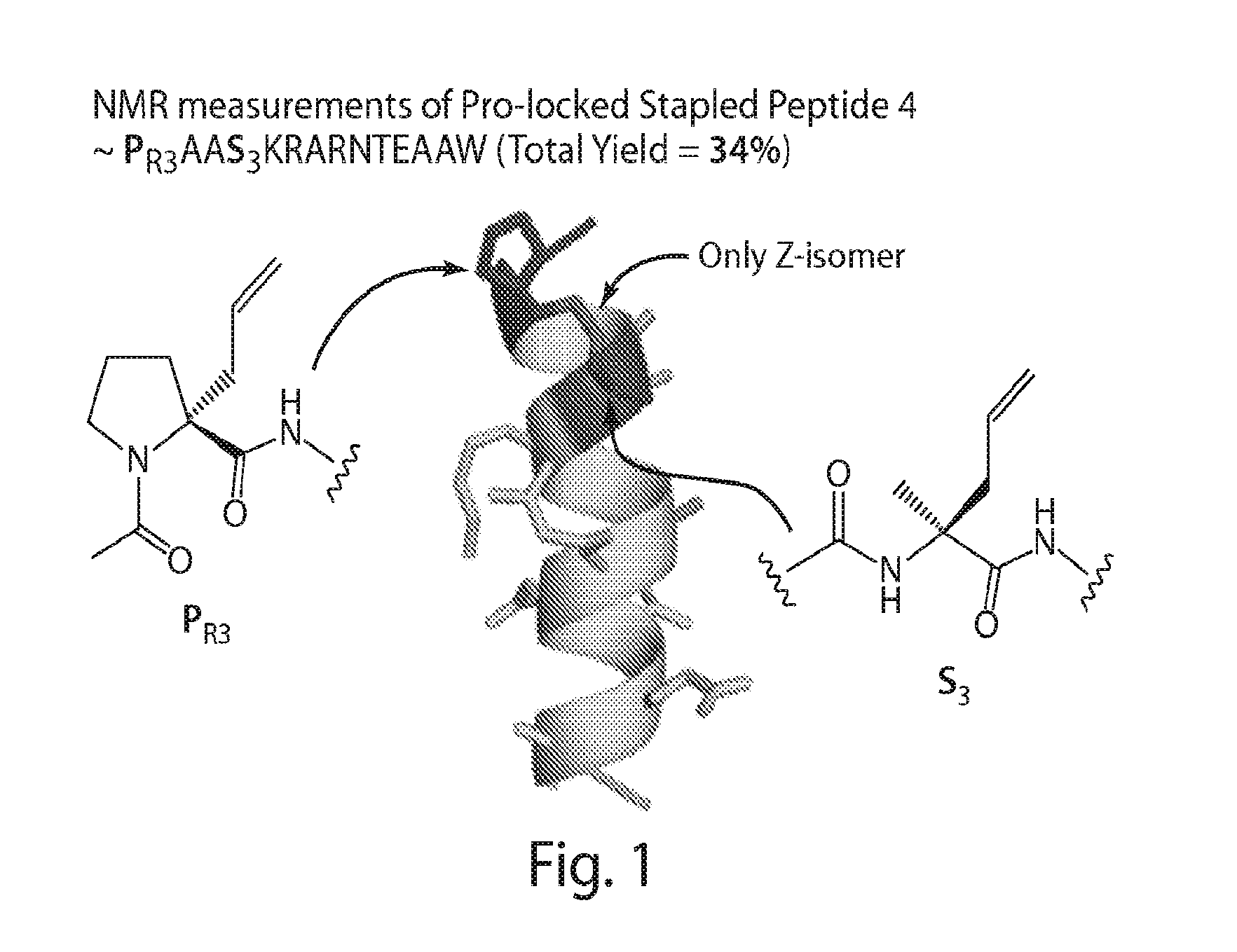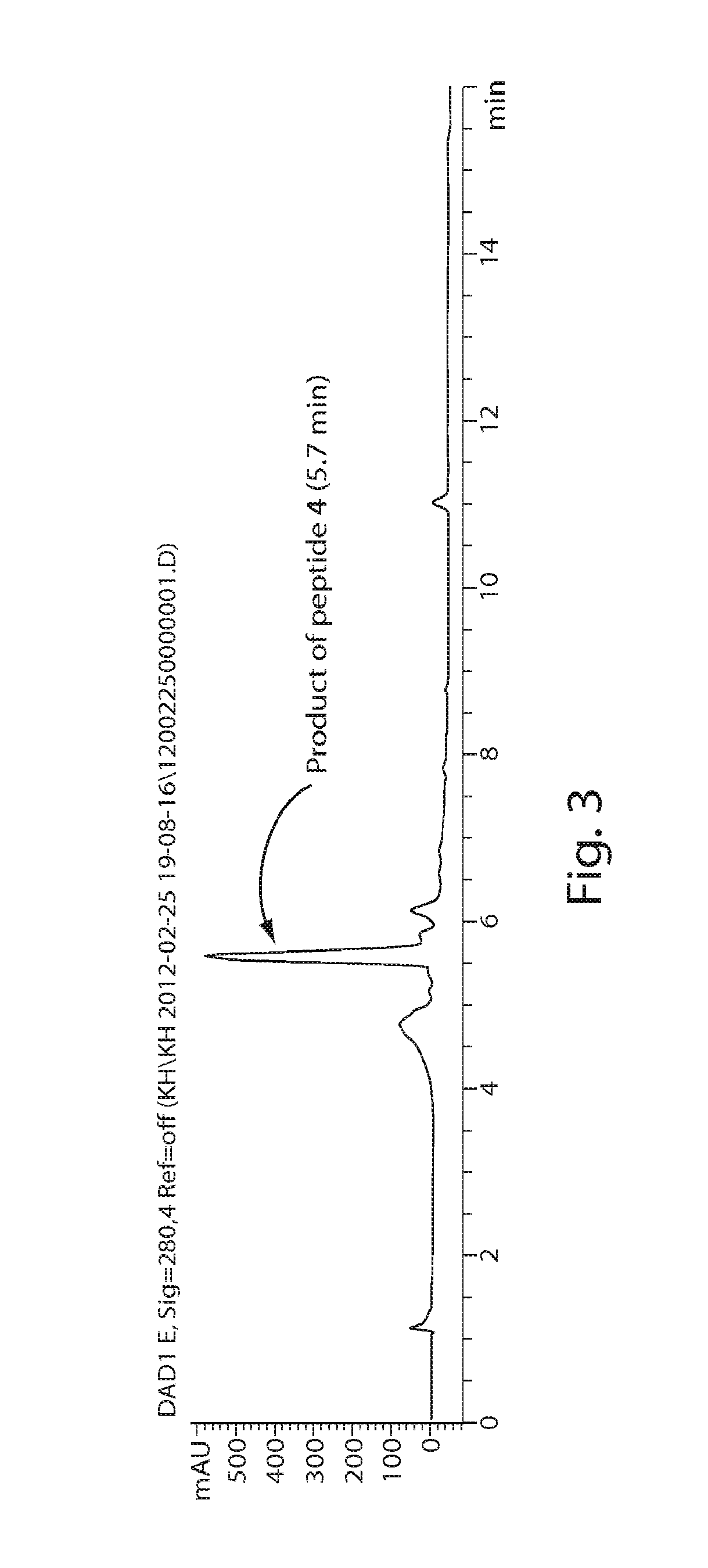Proline-locked stapled peptides and uses thereof
a technology of stapled peptides and proline, which is applied in the field of proline-locked stapled peptides, can solve the problems of difficult initiation of alpha helix formation, difficult ordering, and difficult cross-cell membrane crossing of peptides, and achieve the effect of conferring oral bioavailability on peptides
- Summary
- Abstract
- Description
- Claims
- Application Information
AI Technical Summary
Benefits of technology
Problems solved by technology
Method used
Image
Examples
example 1
Pro-Locked Stapled Peptides
Materials and Methods
[0554](R)—N-(Acetyl)-2-(2′-propenyl)proline (“PR3”), a novel compound, was synthesized via modification of a reported synthetic route, followed by acetylation (Synlett, 1999, 1, 33-36; Tetrahedron, 2005, 61, 10018-10035). A scheme for the synthesis of PR3 is shown in FIG. 11. (R)—N-[(9H-Fluoren-9-ylmethoxy)carbonyl]-2-(2′-propenyl)proline could be used instead of (R)—N-(Acetyl)-2-(2′-propenyl)proline (“PR3”).
[0555]The compound PSO3 (See FIG. 10) allows for the synthesis of linkers originating from a position other than the alpha-carbon. A scheme for the synthesis of PSO3 is shown in FIG. 12. The scheme includes the steps of methyl-esterification, Fmoc protection, introduction of an allyl group and deprotection of a Fmoc group.
[0556]The compound PS3 was synthesized from D-proline following the synthetic scheme for preparation of the compound PSO3.
[0557]The compound PS5 was synthesized following the synthetic scheme for preparation of th...
example 2
Caps for Cloaking Exposed N—H Groups in Peptides
[0568]FIG. 7, FIG. 8, and FIG. 36 provide examples of peptide caps for cloaking exposed amide N—H groups.
example 3
Improving Passive Membrane Diffusion of Peptides
[0569]Cells were grown on chamber slides. FITC-labeled peptides 17 and 18 were added to the cell media at 0.1 microM concentration, and the cells were incubated with the peptide containing cell media. After incubation, the cells were washed and fixed. Cells were stained with DAPI, while the presence of peptide was evaluated using a confocal microscope at a wavelength appropriate for FITC.
[0570]FIG. 24 shows cell penetration of Pro-locked stapled peptide 18. Significant cell penetration of a FITC-labeled Pro-locked stapled peptide 18 was shown at 0.1 microM concentration. In contrast, non-locked WT peptide 17 showed no penetration.
PUM
| Property | Measurement | Unit |
|---|---|---|
| w/w | aaaaa | aaaaa |
| diameter | aaaaa | aaaaa |
| diameter | aaaaa | aaaaa |
Abstract
Description
Claims
Application Information
 Login to View More
Login to View More - R&D
- Intellectual Property
- Life Sciences
- Materials
- Tech Scout
- Unparalleled Data Quality
- Higher Quality Content
- 60% Fewer Hallucinations
Browse by: Latest US Patents, China's latest patents, Technical Efficacy Thesaurus, Application Domain, Technology Topic, Popular Technical Reports.
© 2025 PatSnap. All rights reserved.Legal|Privacy policy|Modern Slavery Act Transparency Statement|Sitemap|About US| Contact US: help@patsnap.com



